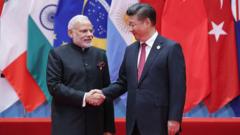As India's economy flourishes, a new generation of wealthy entrepreneurs are gravitating towards modern private member clubs like Soho House, abandoning the traditional gymkhanas and colonial-era spaces. This trend showcases the changing dynamics of social networking among India's elite, highlighting the demand for more inclusive venues that foster creativity and diversity in membership.
The Rise of Exclusive Modern Clubs in India: A Shift from Traditional Elite Spaces

The Rise of Exclusive Modern Clubs in India: A Shift from Traditional Elite Spaces
India's affluent embrace contemporary lifestyle clubs, moving away from old-world colonial hangouts, reflecting a dynamic shift in social networking.
India's rapidly evolving economy has given birth to a brand-new set of affluent individuals, leading a significant shift from traditional private clubs towards more contemporary and inclusive venues. Historically, the elite of India sought refuge in exclusive Raj-era gymkhanas, where access was usually limited to established families, business tycoons, and bureaucratic figures. These ornate spaces, featuring polished wood furniture, ushered the city’s well-heeled class into a world of power dynamics facilitated by golf courses and cigar lounges.
However, as the economy expands and diversifies, a wave of modern private clubs is springing up, catering to a younger, entrepreneurial elite eager for a less formal environment for networking and associates. Industry leaders highlight this evolution: Soho House, famed for its creative-centric ethos, is among those planning new locations in the affluent regions of South Mumbai and Delhi, showcasing the growing hunger for innovative networking spaces that reflect current trends and industries.
This concept emerged from its beginnings in London during the mid-90s, providing a fresh alternative to conventional gentlemen's clubs devoid of creative, modern thinkers. Today, Soho House's allure comes from its ability to offer a social atmosphere free from the limitations of familial legacy or class, setting a trend that contrasts starkly with the more traditional models of exclusivity.
Moreover, the demand for such venues is not just a matter of preference; a shortage of existing options, coupled with long waitlists for traditional clubs, has escalated the market for new entrants. Reports indicate that the contemporary membership club scene in India is on the rise, with over two dozen new initiatives, many backed by global hospitality brands, all targeting the burgeoning wealthy class.
While there’s a notable shift towards democratizing membership – valuing personal achievements over inherited privilege – high annual fees, such as the staggering 320,000 Indian rupees ($3,700), still limit access for many in the broader population. This juxtaposition reflects the new Indian narrative, which caters to the technologically advanced and entrepreneurial while still being tied to the traditions of exclusivity.
In conclusion, the area of modern private-member clubs epitomizes India's changing economic landscape, driving home the point that as the rich get richer, they seek not just luxury but also a more inclusive and collaborative environment to forge connections, despite the evident socioeconomic divides that persist in society.




















